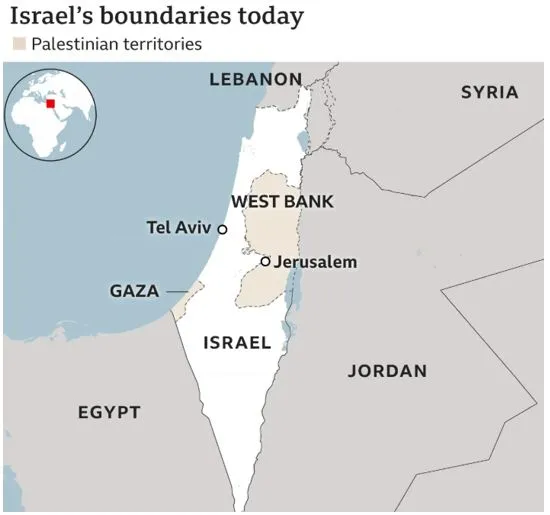

6th May 2025 (14 Topics)
Context
Amid stalled ceasefire negotiations and continued hostilities, Israel’s Security Cabinet has approved a new military plan aiming to capture the entirety of Gaza and maintain a presence for an unspecified duration, increasing pressure on Hamas for hostage release and a ceasefire on Israeli terms.
Key Highlights of the Plan:
- Full Military Control: The Israeli army aims to take over all of Gaza, beyond the half it already controls, including border zones and key east-west corridors.
- Continued Displacement: The plan includes further displacement of Palestinians toward southern Gaza, worsening the humanitarian crisis.
- Strategic Pressure on Hamas: The move is designed to coerce Hamas into concessions, particularly on the hostage issue and ceasefire terms.
- Humanitarian Crisis Deepens:
- Mass Displacement: Over 90% of Gaza’s population (2.3 million) has been displaced — many repeatedly.
- Aid Blockade and Hunger: Since early March, Israel halted aid into Gaza, creating famine-like conditions and widespread looting.
- Casualties: According to local health officials:
- Over 52,000 Palestinians killed, many women and children.
- Strikes since March 18 alone have killed over 2,600.
- Infrastructure Destruction: The territory is described as an "uninhabitable moonscape", with vast devastation and collapsed services.
Background of the Conflict
- The conflict between Israel and the Palestinian people roots go back over a century and are primarily centered on issues such as land ownership, borders, and national identity.
- Before 1948, the region was known as Palestine and was under Ottoman rule until World War I.
- After the defeat of the Ottoman Empire, Britain took control of the area under a League of Nations mandate. The region had a majority Arab population and a minority Jewish community, along with other ethnic groups.
- Tensions began to rise after the 1917 Balfour Declaration, in which Britain supported the idea of establishing a “national home for the Jewish people” in Palestine. While Jews saw this as a restoration of their historical homeland, Palestinian Arabs, who had lived there for centuries, strongly opposed this move.
- Jewish Migration and UN Partition Plan: From the 1920s to the 1940s, Jewish immigration to Palestine increased significantly, especially as many Jews fled persecution in Europe. The Holocaust, in which six million Jews were murdered, further intensified the global Jewish demand for a safe homeland.
- By 1947, Jews made up about 30% of the population. Violence between Jews and Arabs had escalated. The UN proposed a partition plan to divide Palestine into separate Jewish and Arab states, with Jerusalem as an international city. Arab nations rejected this plan, claiming it unfairly favored the Jewish population.
Creation of Israel:
- On 14 May 1948, the Jewish leadership declared the establishment of the State of Israel, just before the British withdrawal.
- The following day, armies from five Arab countries attacked Israel, leading to the first Arab-Israeli war.
- Israel emerged victorious and expanded its territory beyond what the UN plan had allocated.
- Egypt took control of the Gaza Strip
- Jordan occupied the West Bank and East Jerusalem
- Israel held West Jerusalem
- About 750,000 Palestinians fled or were expelled during the war, an event known to Palestinians as the "Nakba," or "Catastrophe." Many became long-term refugees.
- The 1967 Six-Day War: In 1967, tensions again erupted into war, known as the Six-Day War. Israel launched a preemptive strike against Egypt and quickly defeated the armies of Egypt, Syria, and Jordan. Israel captured the Sinai Peninsula and Gaza Strip from Egypt, the West Bank and East Jerusalem from Jordan, and the Golan Heights from Syria.
- This war brought about a new phase of Israeli occupation. Over a million Palestinians came under Israeli control in the West Bank, East Jerusalem, and Gaza. Israel later returned the Sinai Peninsula to Egypt in a 1979 peace agreement but annexed East Jerusalem and the Golan Heights—actions not recognized by most of the international community.
- Key-locations:
- West Bank: The West Bank is home to about three million Palestinians and is considered part of the Occupied Palestinian Territories, along with East Jerusalem and Gaza. Israel retains overall control.
- Jerusalem: Israel controls the entire city and considers it its indivisible capital, while Palestinians claim East Jerusalem as the capital of a future Palestinian state. The city is home to key religious sites for Jews (Temple Mount), Muslims (Al Aqsa Mosque compound), and Christians.
- Gaza Strip: The Gaza Strip is surrounded by Israel, Egypt, and the Mediterranean Sea. Originally occupied by Egypt after the 1948 war, Gaza was captured by Israel in the 1967 war. After Hamas won elections in 2006 and took full control of Gaza in 2007, Israel and Egypt imposed a blockade. Since then, several major conflicts have erupted between Hamas and Israel.

More Articles

